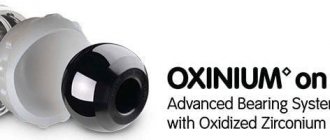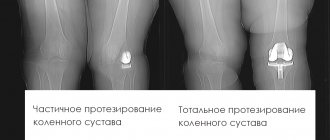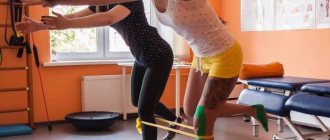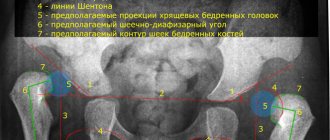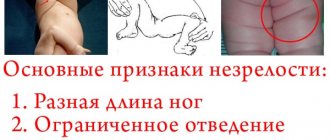Hip endoprostheses (models, friction pairs, revision, oncology)
Stryker offers the following hip replacement components:
Accolade II femoral stems
Accolade II
Accolade II is a morphometric wedge-shaped femoral stem that represents one of the stages in the evolution of wedge-shaped stems. The rod is designed to reach the widest possible patient population. The traditional wedge femoral stem design is modified to provide a specific curvature that allows for more secure fixation in the femoral canal in patients with a wide range of bone sizes.
When using the Accolade II femoral rod, the overall stability of the endoprosthesis increases and the number of intraoperative bone fractures decreases. Over 3.5 years of follow-up, the survival rate of Accolade II was 99.2%.
Key features of Accolade II:
- Unique medial curvature provides increased proximal compliance, which improves stability during implantation;
- the increased proximal-distal ratio ensures reliable fixation and reduces the risk of the rod “falling through” into the femoral canal;
- optimized length - allows implantation through a gentle approach (straight upper or straight anterior) without compromising stability.
Accolade II is cemented in place.
Anato femoral rods
The Anato short anatomical femoral stem is designed using the “fit and fill” principle. The design of the rod provides an optimized rod length and a low-profile side arm, which makes it possible to install it using any method, including gentle access.
Anato rod.
The Anato rod is designed to ensure maximum physiological load distribution on the hip. Stryker's patented PureFix hydroxylapatite coating provides additional secure hold. Anato rods have been used in clinical practice for more than 10 years and during this time they have shown better survival compared to previous similar models.
Exeter femoral rods
Exeter is a femoral rod with a half-century history, which has proven its clinical effectiveness in all types of hip replacement: primary and revision, chronic diseases and traumatic fragmentation of the femoral head.
Stryker Exeter
Exeter rods are made from forged Orthonix stainless steel and are designed for cemented fixation in the femoral canal. Design features include no collar, double tapered stem, and depth markings. Thanks to these factors, the surgeon has the opportunity to adjust the depth of immersion of the implant into the femoral canal, thereby determining the length of the leg within a certain range. A wide selection of models with different lengths and thicknesses of the rod allows you to select a rod for a patient with any features of the anatomy of the hip joint.
In studies, Exeter rods have demonstrated very high survival rates, with one showing a 99.8% survival rate over a 22.4 year follow-up period and another showing a 100% survival rate over a 17 year follow-up period.
Secur-Fit Advanced Thigh Rods
Stryker's flagship development in the field of femoral components of hip replacements. The development took into account more than 20 years of experience in using other models. Design features allow for a greater degree of freedom of movement: flexion/extension - up to 215°, abduction to the side - up to 76°, rotation in the joint - up to 182°. The proximal end of the rods is designed in such a way that it optimally distributes all types of loads affecting the hip joint both at rest and during movement.
SecurFit.
The femoral stem is made of titanium, which is coated with Stryker PureFix HA in the area most tightly in contact with the bone tissue, which provides more reliable adhesion of the implant to the bone. The improved geometry of the neck, which has an ovoid cross-section, provides increased freedom of movement in the joint while maintaining stability of the rod.
The Secur-Fit Plus Max femoral stem allows successful endoprosthesis replacement in patients with any anomalies in the size of the femur and its canal using a single system of non-modular implants.
Restoration Modular Femoral Rod System
Restoration Modular nails are designed to correct proximal-distal discrepancy and for use in severe bony defects of the femur. Designed primarily for revision endoprosthetics.
Hip replacement for arthrosis (coxarthrosis) Treatment free of charge according to quota
Hip replacement
is an operation consisting of replacing a joint affected by arthrosis with an artificial prosthesis. Typically, endoprosthesis replacement is prescribed at the last stage of coxarthrosis, when the disease is already very advanced or other treatment methods do not help. At the end of the progression of osteoarthritis, such an operation is often the only means of restoring the functionality of the hip joint and the ability to move. Surgery is required when the patient is diagnosed with complete destruction of hyaline cartilage. A healthy hip joint is covered with a layer of hyaline cartilage, i.e. The head of the femur and the cavity of the acetabulum are covered with cartilaginous tissue. The presence of articular cartilage allows for shock absorption of human movements and ensures smooth sliding of joints relative to each other. Problems with the functionality of hyaline cartilage lead to the formation of osteoarthritis.
A type of endoprosthesis ( artificial joints)
What is an endoprosthesis?
Hip endoprostheses are necessary for the patient when the “native joints” refuse to work. Outwardly, they resemble a normal human joint, withstand the same load and are used for the same actions as real joints, they can be extended, bent, and with their help it becomes possible to carry out internal and external rotation, adduction and abduction of the limb. Hip implants are completely different - there are several dozen types. Types of endoprostheses according to their design: - Unipolar - only the femoral head of the hip joint is prosthetic. - Bipolar - both the socket and the head of the bone are prosthetic. Types of prostheses according to the method of their fixation:
- Prostheses with a cementless fixation method - the bones are “adjusted” to the endoprostheses (“ingrowth effect”).
It is used most often for younger patients, as they are more likely to need replacement of the prosthesis after it wears out. - Prostheses with a cement fastening method - are securely fixed using a special solution, are very difficult to remove after wear of the prosthesis, therefore they are installed for people with the least activity. — Hybrid type — the cup of the endoprosthesis is fixed using a cementless method, and its legs are fixed using cement. Types of prostheses according to their material (cup - leg):
- Metal - Polyethylene.
Suitable for both sexes who do not play sports and lead a sedate lifestyle. This pair is considered acceptable for elderly and middle-aged people (when revision of the joint due to wear and tear is not required for a long time). This combination has an average lifespan. - Metal - metal. Usually installed on men who lead an active lifestyle (metal prostheses have the longest service life and are considered the strongest). Not suitable for women planning pregnancy, as metal ions tend to penetrate the fetus, increasing the iron concentration by 15%. - Ceramics - ceramics. It is suitable for all patients at any age, but the choice of a ceramic pair is not suitable for many due to their rather high cost. The advantages of this type of prosthesis include their durability and non-toxicity. Ceramics - Polyethylene. A relatively inexpensive type of endoprosthesis. This ceramic combination is better suited for older patients, as in young people with high activity they will quickly fail (they have a high degree of wear and an average lifespan). What can be called an ideal endoprosthesis? Sometimes complications occur during endoprosthetics (approximately 5–15% of all cases). They are caused by the wrong choice of endoprosthesis, instability of the aseptic profile, fracture of the prosthesis in the leg, infections, hematomas, and chronic diseases. Therefore, it is very important to choose the right endoprosthesis. Unfortunately, it is impossible to recommend specific endoprostheses now, since there are no universal models. All dentures are different, and only an experienced specialist can best understand their features. People who know about dentures only from reviews on the Internet are too tempted to make a choice based only on price. Remember: there are quite a lot of high-quality and affordable endoprostheses, and it is not at all necessary that the more expensive they are, the better. And although hip joint endoprostheses should be the most optimal in terms of price-quality combination, what is important in endoprosthetics is the quality of the operation itself, and not the cost of materials. Sometimes incorrect installation of an implant can damage even the most expensive orthopedic product, but a carefully installed mid-price model can last for decades. The main success factor in endoprosthetics is the experience of the surgeon performing the operation, and not the price of endoprostheses. Main manufacturers
Surgeons who do a lot of prosthetics have preferences when choosing prostheses of one type or another. The most important players in the market for the manufacture of high-quality prostheses are the following companies: Smith & Nephew, DePuy Synthes, Stryker, Zimmer - Biomet, Aesculap. Modern medicine offers more than fifty different types of endoprostheses. Each of these modifications provides the same functionality as nature intended. However, the service life is not as long as we would like: the artificial analog can withstand natural loads for up to 15-20 years with a high-quality operation.
Hip replacement.
Before the operation, a consultation with the patient is carried out.
Issues of endoprosthesis replacement, possible complications and risks are discussed, and the size of the prosthesis is carefully selected. The main risks of the operation are associated with the possibility of infection in the body, large blood losses and thrombosis of blood vessels during surgery, and there is also the possibility of dislocation of the endoprosthesis. A couple of days before the operation, the patient is hospitalized and fully examined. The hip replacement procedure itself takes from one and a half to three hours. Endoprosthetics is performed by a highly qualified doctor, because The operation is classified as complex. The procedure consists of removing the hip joint affected by arthrosis and installing it with an artificial implant, consisting, as already mentioned, of metal, plastic or ceramic. In the postoperative period, a group of drugs with analgesic anti-inflammatory action is prescribed. To fix the pelvis in the desired position, a bolster can be placed under the hip area and between the legs. Generally, some activity in the hospital bed is acceptable the day after surgery. The doctor allows you to squat and make some static movements on the second day. With the help of additional means (a crutch), the patient is allowed to move on the third day. Sutures are removed by the end of the second week after endoprosthetics. How to choose a surgeon
Do not think that the best surgeon is an older doctor with various awards. For the success of endoprosthetics, it is not the age of the specialist that is important, but how many operations on the hip joint he has performed. In many clinics you can find 30-year-old doctors who perform 3-5 hip replacements every day. A surgeon who performs at least 50 surgical interventions on the hip joint per year can be considered experienced. In the case of fewer operations, the surgeon is considered a student regardless of the amount of gray hair on his head. In addition to the qualifications of a particular surgeon, you need to study reviews about the clinic where you are going to have hip surgery. The fact is that no matter how experienced the doctor is, without the necessary equipment he will not be able to perform endoprosthetics at the proper level. To carry out the operation, not only the prostheses themselves are required, but also the “correct” instruments (power equipment and other materials considered consumables). When choosing a surgeon, it is better to give preference not to a “professor with titles”, but to a practicing specialist. There are many different endoprostheses, differing in type of fastening, structure, and service life. It is better not to buy a prosthesis yourself. Trust your surgeon to choose the appropriate endoprosthesis.
Rehabilitation after surgery. The patient is discharged 10-12 days after the operation. Further rehabilitation is carried out at home, following all doctor’s instructions. In the event of a complication of endoprosthetics, it is advisable to transfer the patient to a special rehabilitation center, where proper monitoring and care by rehabilitation doctors will be provided. The person being operated on must comply with the load restrictions on the artificial hip joint. Typically this period is up to two months. Complications range from 5 to 15% of all operations. Every year this percentage becomes smaller, because... The technique is constantly being refined and more advanced means are being used for successful rehabilitation. After 95% of endoprosthetics operations performed for coxarthrosis, a person again gets the opportunity to move, bend, returning to normal life, even playing sports. The service life of the endoprosthesis is 15 years, maximum 25 years. It should be noted that the more load the prosthesis receives, the faster the implant wears out. The service life of a hip replacement is reduced by excess weight and high mobility (applies to athletes returning to their previous lifestyle).
Trident Acetabular System
The acetabular component of the Trident Acetabular System hip endoprosthesis is equipped with a patented locking element that minimizes wear on the endoprosthesis with an increased range of motion.
Modular Dual Mobility
Anatomic Dual Mobility X3 acetabular system
The ADM acetabular system is a combination of a large diameter endoprosthesis acetabular cup and a X3 polyethylene support liner. The peculiarity of the design is that the system is anatomically adapted and is available in two versions - for the left and right thigh. ADM X3 is based on the principle of dual mobility with two reference points. The ADM X3 bowl is a one-piece bowl made from titanium-plated cobalt-chromium alloy with a self-locking zone for press-fit installation.
Acetabular system Modular Dual Mobility
MDM acetabular cups are high-quality modular acetabular endoprostheses designed to prevent endoprosthesis dislocation. MDM X3 bowls are modular, have screw holes and are compatible with Trident and Tritanium components. The stability of these components is achieved through the low friction design and relatively large head size. These cups are made of cobalt-chromium alloy with titanium coating and are intended for both primary and revision endoprosthetics.
Revision hip prostheses
Stryker Orthopedics offers a wide range of different elements for revision replacement of endoprostheses.
Restoration HA Hip Stem System.
Titanium system endoprosthesis. Designed for repeated operations. Provides increased mechanical stability due to its roughened surface and hydroskiapatite coating. The geometry of the implant takes into account the positive 12-year clinical experience with the Omnifit HA model used for primary surgeries.
The system includes straight femoral stems in lengths of 15 cm and 20 cm, curved stems in lengths of 20 cm for Types 1, 2 and some cases of Type 3 revision surgery, and curved stems in lengths of 25 cm for cases with severe bone loss.
PS Hip Stem
Rods in 15, 20 and 25 cm lengths are made of hardened titanium with porous plasma spraying, which provides high rotational and axial stability. The distal end is cylindrical for diaphyseal fixation.
Stryker hip endoprostheses are now present in the arsenal of almost every serious medical institution that values its reputation, since these are one of the most reliable and versatile implants for various clinical cases.
Stryker Knee Endoprostheses
Triathlon Total Knee Prosthesis
Triathlon knee joint endoprostheses are designed taking into account the biomechanics of knee joint movements, based on many years of experience in the use of other endoprostheses. The design of the endoprosthesis takes into account the “neighborhood” of soft tissues and minimizes the load on them. This allows for high mobility of the endoprosthesis and shortens the recovery period after surgery. These properties are achieved through the following design features:
- uniform radius of movement of the endoprosthesis - this reduces the degree of instability due to uniform tension of the collateral ligaments throughout the entire range of motion in the range from 10 to 110°;
- shortened posterior condyles - provide freedom of knee flexion up to 150°;
- the beveled inner edges of the condyles of the endoprosthesis leave sufficient freedom for internal-external rotation of the tibia;
- the articular surface of the tibial liner, made in the form of a spherical arc, provides rotational mobility up to 20° while maintaining the tibiofemoral contact area even with deep flexion;
- The S-shaped groove on the endoprosthesis under the patella provides anatomical movement of the patella and reduces the load on it at the deepest flexion.
Where can I buy
You cannot buy Stryker endoprostheses on your own, and there is no need to do this - not a single doctor, not a single clinic will undertake to install an endoprosthesis purchased independently by the patient. If you want to install a specific model of an endoprosthesis from Stryker, you will have to look for a clinic that works with distributors of this company in Russia.
Reliable information about the price and conditions for purchasing Stryker endoprostheses can be found in the customer support center +1 269 385 2600. The Russian representative office of Stryker is located at:
Moscow, Leningradsky Prospekt, 39/80, 3rd floor, SkyLight Business Center, Tower “B”. Phone: 7 495 785 0718.
Source
Types of hip implants
The manufactured hip replacements are of high quality. This applies to all manufacturers operating in Europe or the USA. Therefore, it is incorrect to talk about which prosthesis is better or worse.
The main difference between endoprostheses is the friction pair formed due to the materials from which the head and the artificial acetabulum (or liner) are made.
- Metal-polyethylene. The metal head is not resistant to wear, and the complex polymer of the liner inserted into the acetabulum reduces friction. This is an economical option, since the price in Moscow is low.
- Metal-metal. A frequent combination of materials, which is used less and less due to frequent complications due to metal friction products.
- Ceramics-ceramics.
The most expensive option, as it is technically difficult to produce. Has minimal friction with rare complications after installation. Ceramics have a high price, since the price is approximately 2 times higher than analogues. Types of friction pairs. - Ceramics-polyethylene. The “golden mean” of all types of artificial joint designs. The price is combined with low friction and high wear resistance. The femoral head is made of ceramic, and the liner is made of a complex polymer. Feedback from patients with this type of construction installed is positive.
Pink - ceramics, white - polyethylene.
Risk level during surgery
Hip replacement surgery is effective, but any intervention in the internal environment of the body is stressful for its organs and systems. Therefore, this surgical intervention is prescribed when it is not possible to cure the joint using conventional methods. Before prescribing surgery, the functional and anatomical state of the joint is assessed:
- The integrity of the cartilage tissue - if more than half of its surface is smooth and even, there are no areas of necrosis - conservative treatment is prescribed;
- Condition of the joint cavity - you can do without surgery if the joint space is within the acceptable norm, its edges are smooth throughout, there are no adhesions between the surfaces;
- The presence of synovial fluid - surgery will be required if there is no lubrication in the joint or its amount is minimal, and the viscosity is increased.
Today it is common to install artificial prostheses, but sometimes the body’s own tissues are used.
In case of severe deformities and progression of pathology against the background of the lack of effect from traditional treatment, surgical intervention to replace the hip joint is necessary.
Surgery on the hip joint helps restore the functions of the lower extremity - eliminates deformation, provides full movements in which a person can walk, run, live a normal life, and, if desired, play sports.
Connective tissue, being destroyed under the influence of causative factors, is no longer capable of regeneration. Conservative therapy, no matter how effective it is, can only slow down the pathology and restore cells that have just begun to break down. Therefore, if a patient misses the chance of timely treatment with medications and strengthening procedures, surgery cannot be avoided.
Main indications for endoprosthetics:
- Most often, arthrosis leads a patient to surgery - the disease progresses quickly and does not always respond to conservative therapy. As pathology develops, articular cartilage gradually dies and is rejected by the body. Patients who are indicated for surgery for arthrosis usually have difficulty moving or can no longer walk at all;
- Age-related joint destruction - this problem most often appears in old age, when circulatory disorders appear. Against the background of reduced blood flow, the renewal of connective tissue cells slows down, cartilage becomes less elastic, becomes thinner and undergoes destruction. First, the doctor will prescribe medications, physiotherapy and exercises, and if this does not help, surgery;
- Injuries – most often fractures of the femoral neck in old age lead to surgery. With this disorder, bone fragments do not heal or severely deform the leg. If the patient is able to undergo surgery, this is the only way to avoid disability;
- Local inflammation - in advanced stages, some inflammatory diseases contribute to joint deformation or ossification. For these disorders, medications are powerless and surgery is necessary.
Each implant has its own service life - usually replacement is required once every 15-30 years.
Hip replacement surgery returns the patient to a full life, but sometimes it is impossible to carry out.
Main contraindications to surgical treatment:
- Inflammation in the joint cavity and surrounding tissues;
- The presence of a chronic infection in the body;
- Presence of chronic diseases;
- Infectious diseases.
With active inflammatory processes, effective surgery is impossible - the risk of complications increases. Some chronic diseases contribute to immune dysfunction, which leads to implant rejection. If there is a chronic focus of microbes in the body, after surgery there is a risk of them entering the bloodstream and spreading throughout the body.
Depending on the method of execution, there are several types of surgical treatment. In some cases, a complete replacement of cartilage tissue is carried out, in others, only one bone element is removed and an endoprosthesis is placed. The cost of hip replacement surgery depends on the type of endoprosthetics.
- Partial endoprosthesis replacement is allowed if one of the hip surfaces is even and smooth. During surgery, the head is removed and a metal substitute is placed in its place. The average price of partial endoprosthetics is 90 thousand rubles;
- Replacement of surfaces is carried out if only the cartilage is deformed, and the bone has not undergone pathological changes. The articular cartilage is removed and movable artificial elements are installed in its place. The price of this operation is 120-130 thousand rubles;
- Total endoprosthetics is the most complex and effective treatment method. In this case, the bone and cartilaginous components of the joint are removed - the head of the femur and the glenoid cavity, which are replaced with artificial prostheses. The cost of this operation is 150-180 thousand rubles.
The prosthesis can be fixed with cement, or holes are made in it into which local tissues grow, strengthening it. Sometimes there are mixed technologies. In the first case, rehabilitation is shorter.
Every patient agreeing to a surgical option for hip treatment should know how to prepare for surgery. After talking with the doctor, consulting with family and deciding on surgical treatment, the patient will have to undergo a medical examination.
Within a month, the patient undergoes a medical examination, as well as some laboratory and instrumental examinations. The purpose of such a study is to identify possible complications that may be contraindications to surgery. During this period, it is necessary to begin treatment of chronic diseases in order to avoid additional complications.
The rehabilitation period will be much shorter if the hip muscles are strengthened - so it is advisable to start training under the supervision of a physiotherapist. It will not be a bad idea to master walkers and crutches in advance - you will have to actively use them for the first few months. Doctors strongly recommend giving up bad habits that can cause complications in the respiratory and digestive systems.
A few days before surgery it is recommended:
- After discharge from the hospital, it will be difficult to move around. All items should be placed within easy reach at home. If necessary, rearrange the furniture so that it is easier to walk around the room and get up to go to the toilet;
- Collect necessary things, personal hygiene items, food and medicines for the hospital;
- Warn family and friends that the patient will not be home for the next couple of months;
- Practice using crutches and walkers.
Further preparation requires mandatory hospitalization of the patient in a hospital. The patient talks with the doctor, fills out the necessary documents, receives all the necessary information about the operation and the recovery period. All tests must be rechecked, and some must be taken again to be on the safe side.
The day before endoprosthetics, the patient discusses the type of anesthesia with the anesthesiologist. The consumption of spicy and salty foods is prohibited - this is due to the fact that from midnight the patient will not be able to drink any liquid. You are allowed to eat in the evening - but not too late. Breakfast is not allowed. These conditions must be observed for the normal effect of anesthesia and to prevent the development of its complications.
A few minutes before surgery, an elastic bandage is applied to the healthy leg to prevent blood clots.
Execution technique
Joint replacement surgery is a complex operation that can only be performed by an experienced doctor. In modern surgery, operations are increasingly performed using minimal incisions - this reduces tissue damage, reduces postoperative swelling, inflammation and shortens the rehabilitation period. How long the operation lasts depends on the type of hip prosthesis installed and the experience of the surgeon.
The course of the operation includes the following stages:
- The patient is placed on his side, on the healthy side - in this position the operated hip area is in a comfortable position;
- The surgeon makes the necessary vertical cuts along the muscle fibers and ligaments, minimizing their damage;
- After entering the hip cavity, the doctor removes bone elements and, if necessary, grinds down healthy bone for the implant;
- The doctor places a metal prosthesis into the joint, pre-fixes it, takes measurements of the operated leg, and “adjusts” them - if the length and shape match with the opposite limb, tightly fixes the artificial joint;
- Finally, the doctor treats the hip area with antiseptics, sutures the tissue and leaves a drainage - a medical tube to remove blood and fluid. After a few days, the drainage is removed.
After the patient has come to his senses after anesthesia, minor complications may appear in the form of weakness, deterioration of health, and sometimes nausea and vomiting. Usually, after a few hours, these symptoms disappear; if the condition has not returned to normal, symptomatic therapy is prescribed. To avoid bacterial infection, a course of antibacterial drugs is prescribed - usually broad-spectrum antibiotics are used.
The rehabilitation period requires hospitalization for the first 2-4 weeks, then according to the recommendations of the attending physician. The first days you will have to lie on the bed, doing minimal exercises. Then, under the supervision of staff, movement with the help of a walker, a course of exercise therapy and physiotherapy are allowed. Without rehabilitation after surgery, endoprosthetics will not be successful.
Surgical reconstruction of the hip joint is a very expensive treatment option that not everyone can afford. But any patient has the opportunity to receive a quota for surgery.
Patient reviews
How are dentures fixed?
The difference in design depends not only on the friction pair. In some patients, the acetabulum, to which the head of the femur is attached, is also affected. In this case, the doctor will have to replace both parts of the damaged joint. This operation is called total endoprosthetics.
Types of implant fixation in bone:
- Cementless prosthesis. Both unipolar and bipolar prosthetic devices can be inserted into the patient's own femur without the addition of fixation cement. It is used in young patients to increase the durability of the product.
- Cement. Necessary for elderly patients and those with autoimmune diseases. Due to the fragility of the own femur, the pin of the metal structure is additionally strengthened with cement. The effect on rehabilitation is insignificant, since the installation of any friction pair is possible.
Layout diagram.
Any artificial structure will last for many years if used properly. The main disadvantage of ceramic dentures is fragility and a characteristic crunch. If the first problem makes itself felt in 0.5% of all patients, then judging by the reviews, the crunching in the operated joint, clearly audible by other people, worries many.
Long term prospects
Total endoprosthetics allows you to completely eliminate pain, improve the functional abilities of the joint and improve the patient’s quality of life. If there are no complications after surgery, the patient can return to an active lifestyle. Regardless of age, surgery is an effective method of both medical and social rehabilitation.
After endoprosthetics, all patients require periodic X-ray examination and CT scanning of the operated joint area. They are performed for the purpose of early diagnosis of endoprosthesis instability.
Knee/hip replacement is not a reason to stop basic anti-inflammatory, hormonal and genetic engineering therapy. On the contrary, all patients require further conservative treatment with adequate doses of medications. This is necessary to suppress disease activity and prevent further joint destruction.
Hip joint: price of prosthesis
The pharmacy does not sell artificial implants for endoprosthetics. They are handled by several companies in large cities. The price will depend on several factors:
- dealer markup;
- brand;
- design features;
- purchase directly from an official representative or through an intermediary in a hospital;
- quality of workmanship and specific model of the prosthesis.
Endoprostheses from almost all companies are represented in Moscow. The cheapest implants are offered by the Taiwanese “UOC”, but doctors’ reviews of this manufacturer are quite wary. The essence of the low price is obvious - Chinese and Taiwanese companies are simply cloning models of European companies.
A titanium prosthesis from a well-known manufacturer in Moscow costs 99-120 thousand rubles. Asian designs are about 2 times cheaper. If the friction pair is ceramic-ceramic, then the price fluctuates around 200 thousand rubles. The average bill for a classic metal-polyethylene design does not exceed half that of a ceramic product. When purchasing in a hospital, additional markup is possible, masked by additional medical services.
Buy a hip prosthesis in Moscow
Before purchasing an artificial implant yourself, you need to discuss its design with a specialist. It is important to consider the lifestyle the patient leads. If you are actively involved in sports at a young age, you will have to choose durable, special designs. Prices in Moscow:
How much a hip joint implant costs in the capital of the Russian Federation depends on many reasons, especially on the manufacturer. However, a ceramic endoprosthesis is always 50-70% more expensive.
Minimally invasive endoprosthetics in the Czech Republic: doctors, rehabilitation, terms and prices.
Find out more
Results
The need to replace large joints in patients with RA arises in two cases:
- with high disease activity, which has led to severe damage to the knee/hip joint;
- with concomitant aseptic necrosis, deforming osteoarthritis and osteoporosis.
Performing surgery for rheumatoid arthritis is associated with a number of difficulties. To achieve good results, doctors need to rationally combine conservative and surgical treatment methods. Patients with RA require hormonal, basic anti-inflammatory and genetically engineered drugs. They also need enhanced prevention of thromboembolic and infectious complications.
Today, doctors are trying to use a rational approach to the treatment of rheumatoid arthritis. It consists of the early prescription of adequate doses of DMARDs, careful monitoring by a rheumatologist of the effectiveness of treatment, and timely connection to GEBD therapy. On the one hand, this reduces the need for further endoprosthetics, on the other hand, it reduces the activity of the disease and generally improves the results of surgical treatment.
Zimmer - hip prostheses
Is it possible to install these prostheses? The answer is yes, since the products undergo multi-level control in production and then are installed on patients. Those patients who have had a hip joint replaced report the highest quality of life after several months of rehabilitation. Reviews indicate that the service life of Zimmer prostheses exceeds 15 years. It is not possible to interview many patients because due to their advanced age they die due to natural causes. During pathological autopsies, low wear of structures is noted even after many years of operation.
The main advantages of Zimmer endoprostheses can be summarized as follows:
- price;
- huge range of models;
- ease of installation;
- reliability of design;
- long service life;
- low rate of complications;
- wide distribution network.
How long does a prosthesis last for patients? With proper use, the patient will be able to move fully throughout his life. More than 75% of people end their lives with a primary implant.
For zimmer designs, the service life is specified in the instructions for use of the product. How many years does the manufacturer guarantee? Minimum 8 years of full movement. The prosthesis does not add weight to the patient’s body, since how much the product weighs is strictly specified in the contract with the buyer. Weight, depending on the design, does not exceed 500 grams. Patients are always interested in the question: is it possible to run or engage in active sports? But in this case, the answer depends on the brand of the installed structure. With ceramic prostheses, active sports, including running, are allowed.
Installation of an endoprosthesis for rheumatoid arthritis
The resulting antibodies attack the synovial membrane of the joints and cause the development of an inflammatory process in it. Over time, inflammation spreads to periarticular tissues, cartilage and even bones. This leads to their gradual destruction. Over time, the affected joints become deformed and cease to cope with their functions. A person begins to experience severe pain, which is difficult to treat and intensifies over time.
In the initial stages, RA manifests itself with the following symptoms:
- morning stiffness in the joints, which disappears during the day;
- slight increase in temperature, periodic insomnia and lack of appetite;
- the appearance of characteristic rheumatoid nodules, most often on the extensor surface of the elbows;
- progressive pain and deformation of the affected joints if left untreated.
As a rule, autoimmune inflammation first affects the small joints of the hands. Later, large joints (knees, hips) can become inflamed with the development of gonarthrosis and coxarthrosis. Their defeat in the future leads to the need for surgical intervention.
However, rheumatoid arthritis is not always a reason for endoprosthetics. The need for joint replacement often occurs in people with avascular necrosis, deforming arthrosis and osteoporosis. These diseases can also cause severe knee/hip injury. In this case, RA is only a concomitant pathology that complicates the operation.
In patients with highly active RA, massive damage to the synovial membranes and destruction of bone tissue (significant thinning of the walls and floor of the acetabulum of the hip joint) are usually detected. In this case, during the operation, doctors have to perform a total synovectomy, reconstruction of the acetabulum and plastic surgery of bone defects.
In the later stages of RA, in almost all patients, blood circulation and microcirculation in the soft tissues of the extremities are impaired, and periarticular tissues are also damaged. Many patients experience immunosuppression while taking medications. All this increases the risk of developing infectious and thromboembolic complications.
The key to successful arthroplasty in RA is to reduce disease activity before planned surgery and prevent osteoporosis. If the patient has not received basic anti-inflammatory and genetic engineering therapy, he is first recommended to undergo a course of treatment. Surgery is planned only when the disease activity is low.
Note that performing endoprosthetics does not require discontinuation of basic and hormonal medications before surgery. However, medications should be discontinued at least 4-6 months before surgery. Otherwise, the patient increases the risk of developing tuberculosis and other opportunistic infections, including antibacterial ones. Doctors determine when to resume taking GIBP on an individual basis after surgery.


